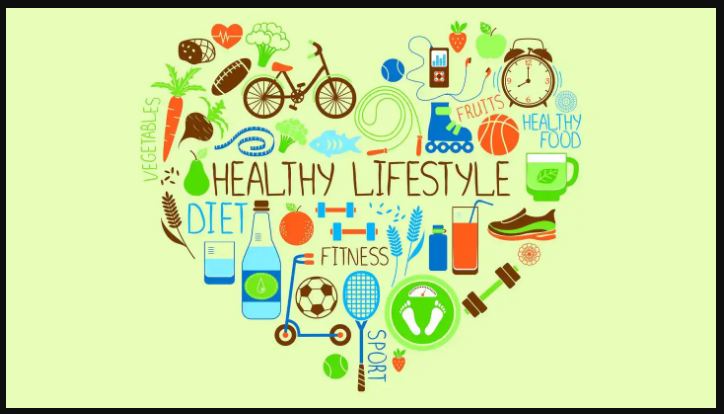Do you want to get going on the path to a better lifestyle? We all know the benefits of living healthy, such as improved mood and increased energy, but taking those first steps can be complicated. That’s why we’ve put together this easy guide: five simple steps that anyone can follow to start living a healthier life. In this article, we’ll look at how to get the right amount of sleep, exercise regularly, eat a balanced diet, stay hydrated, and practice mindfulness – so you can start enjoying the benefits of better health today.
These are five recommendations for leading a healthier lifestyle.
Our physical, mental, and emotional well-being depends on leading a healthy lifestyle. A healthy lifestyle can help reduce disease risk, improve mood and energy levels, and increase life expectancy. But it can be challenging to make the first steps towards living healthier – that’s why we’ve put together this easy guide: five simple steps that anyone can follow to start living a healthier life.
In this blog post, we’ll look at how to get the right amount of sleep, exercise regularly, eat a balanced diet, stay hydrated, and practice mindfulness – so you can take advantage of enhanced health immediately.
When it comes to getting enough sleep, aim for seven to nine hours every night by going to bed and waking up at consistent times. Exercise should be part of your routine; three times a week, 30 minutes of moderate exercise is recommended. Eating a balanced diet means including plenty of fresh fruits and vegetables and consuming lean proteins like fish or chicken. Staying hydrated is also essential; drink eight glasses of water daily for optimal health. Finally, practicing mindfulness helps us become more aware of our thoughts and emotions to manage stressors in life better; try meditating for 10-30 minutes every day or listening to guided meditation audio tracks if you’re new to meditation.
Following these five steps, you can start living a healthier lifestyle today – enjoy improved moods, increased energy levels, and better overall health!
Get the Right Amount of Sleep: Benefits, hours needed, tips for getting to sleep.
A healthy lifestyle depends on getting enough sleep each night. While it may seem obvious, many people need more rest due to busy schedules or poor sleeping habits. Adequate sleep is essential for improved mood, alertness, and memory. It can also help keep your body functioning properly and reduce the risk of chronic diseases.
The amount of sleep needed varies by age, but adults generally need seven to nine hours each night, teens need between eight to 10 hours, and children aged five to 12 need nine to 12 hours.
To ensure you are getting the proper amount of restful sleep each night, here are some tips: Developing a consistent sleep routine will help your body know when it’s time for bed; Reducing your exposure to blue light from electronic devices before bedtime; Creating a comfortable sleeping environment that is dark, cool (around 65 degrees Fahrenheit), and quiet; Avoiding caffeine late in the day; Exercising regularly throughout the day; and avoiding long naps during the day.
By following these steps, you can get the right amount of sleep to enjoy the benefits of improved mood, increased energy levels, and better overall health. With regular practice, you can create healthy habits that will benefit both the short-term and long-term as you strive toward healthier lifestyles.
Exercise Regularly: Types of exercises, when to exercise, benefits
Regular exercise is crucial to leading a healthy lifestyle. Not only will it help you look and feel better, but it can also provide a host of physical and mental health benefits. From improved mood and increased energy levels to better sleep and lower risk of chronic diseases, exercising regularly can make all the difference in your overall well-being.
When you are starting with exercise, it is essential to find activities that you enjoy doing, and that fit into your lifestyle. Many types of physical activities are available, ranging from light-intensity exercises such as walking or yoga to more intense activities like running or weight lifting. Finding the correct type of exercise for you will depend on your fitness goals and preferences. Additionally, regular exercise should be complemented with stretches and other forms of movement throughout the day for maximum benefit.
Technology can be an excellent tool for tracking progress when reaching fitness goals. Many apps today offer ways to follow workouts, food intake, daily steps, hydration levels, sleep patterns, and more – all in one place. This information lets you easily adjust your routine based on what works best for you. Additionally, tracking progress through technology helps hold yourself accountable so that staying motivated over time is more accessible.
Finally, incorporating physical activity into your daily routine is key to achieving long-term success with exercise. It takes time to form new habits – so start small by setting realistic goals and staying consistent until they become second nature! You could walk after dinner every night or join an online workout class once per week – whatever works best for you! It is essential to stick with it so that exercise becomes part of your routine rather than something intimidating or overwhelming.
You can start living a healthier lifestyle today by following these simple steps – finding the correct type of exercise for yourself, taking advantage of technology, and making exercise part of your daily routine! Not only will this help improve mood and increase energy levels in the short term, but it has also been linked to reducing risk factors associated with chronic diseases in the long run!
Eat a Balanced Diet: What foods to include in a balanced diet, how to make healthy eating fun.
Leading a healthy lifestyle requires eating a balanced diet. Plenty of fruits and vegetables, whole grains, lean meats, and healthy fats should all be a part of a balanced diet. Eating these foods provides essential vitamins, minerals, and other nutrients that are necessary for feeling energized and sharp throughout the day.
Making healthy eating fun can help you stick to your dietary goals. Try exploring new recipes or cuisines to add excitement to mealtime – even small changes like adding spices or trying new ingredients can make meals more exciting and enjoyable. Visiting local farmer’s markets is also a great way to find fresh ingredients and learn about different products available in your area.
It’s also essential to track what you eat to know if you are getting the right amount of nutrients daily. An accurate record of what you consume helps ensure you get all the vitamins and minerals your body needs for optimal health. You can use apps or websites to track what you eat; many have features that allow you to set daily goals based on the type and amount of food consumed daily.
By following these tips, you can make healthier choices while enjoying your meals! Incorporating plenty of fruits and vegetables, whole grains, lean proteins, and healthy fats into your diet while tracking your intake will help ensure you get all the essential nutrition needed for a healthy lifestyle.
Stay Hydrated: Benefits of staying hydrated, how much water to drink per day.
Staying hydrated is essential to maintaining a healthy lifestyle, as it helps keep your body energized, alert, and functioning correctly. Hydration also plays an important role in keeping your skin looking and feeling healthy and aiding in proper kidney function. The recommended daily amount of water is 2-3 liters, depending on the individual’s needs.
To make drinking this amount of water easier each day, try adding fresh fruit or herbs like lemongrass or mint to your water. This can give it some flavor without adding sugars or artificial sweeteners. You can also purchase flavored waters that are low in sugar or calories but still give you the desired taste.
Another great way to stay hydrated is by drinking beverages high in electrolytes, like coconut water and sports drinks. These drinks contain minerals like sodium, potassium, and magnesium that help replenish lost electrolytes due to sweating during exercise or illness. Additionally, they can help reduce muscle cramps caused by dehydration. It’s important to note however that these drinks should be consumed sparingly due to their added sugar content so be sure to read labels carefully before purchasing them.
Finally, be aware of other sources of liquid you may be consuming throughout the day, such as coffee and tea, which can dehydrate if consumed too frequently or in large quantities. If you enjoy these drinks regularly, remember to balance them with plenty of plain water throughout the day!
By following these simple steps for staying hydrated daily, you can start living a healthier lifestyle today and reap the benefits such as improved mood, increased energy levels, and better overall health!
Practice Mindfulness: Benefits of mindfulness, techniques for practicing it
Mindfulness is a practice that can help individuals reduce stress, anxiety, and depression, as well as improve focus and concentration. It has been found to increase self-awareness, self-compassion, and resilience. Practicing mindfulness can help people lead healthier lifestyles by cultivating positive habits and behaviors.
Fortunately, there are many techniques for practicing mindfulness. One of the most popular ways of practicing mindfulness is through meditation. Mindful meditation helps to cultivate stillness in the body and mind while focusing on the present moment. It can help clarify one’s thoughts and feelings while calming the nervous system.
Eating mindfully is another approach to practicing mindfulness. This involves paying attention to how you feel before, during, and after eating – noticing how different foods make your body feel. Additionally, it helps you become aware of external factors such as portion sizes or where your food comes from, which can influence how satisfied you feel after eating.
Deep breathing exercises are another valuable technique for practicing mindfulness; they involve focusing on each breath as it moves in and out of the body with slow, steady breaths which help relax both mind and body. Finally, journaling can be a great way to express emotions or track progress with your mindfulness practice; by writing down your thoughts and feelings, you become more aware of them, which helps foster emotional intelligence skills such as self-regulation or empathy towards others.
To get started with any mindfulness practice, set aside 10 minutes each day for meditation or mindful breathing exercises; if sitting still is difficult, then consider going for a mindful walk or engaging in mindful eating instead! With consistent effort, these practices will start to pay off and you will begin to experience the benefits that come with living a healthier lifestyle today.





